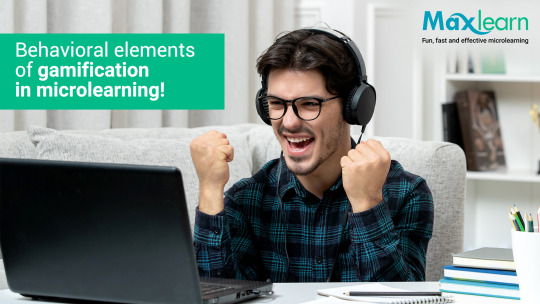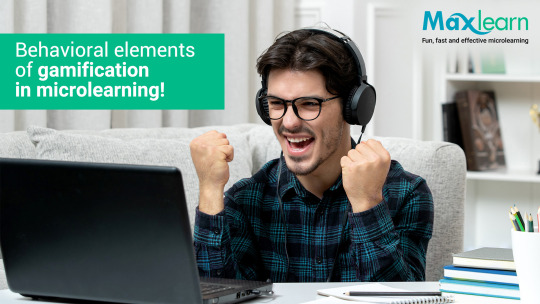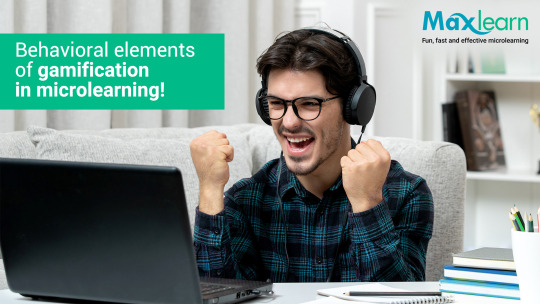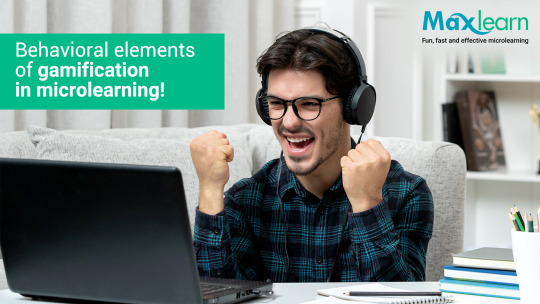#micro learning examples microlearning best practices how to create microlearning
Explore tagged Tumblr posts
Text
Why the DDE Framework is Essential for Microlearning Game Success

Maximizing Engagement with the DDE Framework for Game Design in Microlearning
In the ever-evolving landscape of digital learning, microlearning has emerged as a powerful tool to deliver knowledge in concise, engaging bursts. But how can learning designers ensure that these microlearning experiences are not just informative but also immersive and impactful? The answer lies in thoughtful game design—more specifically, in adopting a strategic approach like the DDE Framework: Discover, Design, Evaluate. This three-phase model provides a structured pathway to creating effective, gamified microlearning experiences that resonate with learners and drive performance outcomes.
Understanding the DDE Framework
The DDE Framework offers a systematic approach to integrating game mechanics into microlearning. It comprises three distinct yet interconnected stages:
Discover – Understand the learners, learning objectives, and context.
Design – Develop game elements and mechanics aligned with learning goals.
Evaluate – Test, assess, and iterate based on learner feedback and outcomes.
This framework ensures that gamification isn't just about adding points or badges but is intentionally crafted to enhance learning outcomes.
1. Discover: Laying the Foundation
The Discover phase is all about research and understanding. Before any gamified microlearning experience can be designed, it’s essential to have a deep understanding of:
Learner Personas: Who are the learners? What motivates them? What challenges do they face?
Learning Goals: What are the specific knowledge or skills learners need to acquire?
Context of Learning: Where and how will the learning take place? What devices will be used? Are learners mobile or desk-based?
This stage may involve surveys, interviews, or collaboration with subject matter experts to gather insights. The aim is to build a solid foundation upon which all design decisions will be based.
Key Questions in the Discover Phase:
What are the performance gaps this training should address?
How tech-savvy are the learners?
What intrinsic or extrinsic motivators will drive learner engagement?
Without a thorough discovery process, there’s a risk of creating a game experience that looks exciting but fails to deliver meaningful learning outcomes.
2. Design: Crafting the Experience
Once a clear understanding of the learners and objectives is established, the Design phase focuses on developing the actual learning game. This includes creating:
Game Mechanics: These could include point systems, levels, challenges, leaderboards, and rewards.
Narratives or Themes: Storylines that provide context and emotional engagement.
Feedback Loops: Immediate feedback helps learners understand their progress and reinforces learning.
Microlearning Structure: Short modules that are bite-sized yet interconnected for continuity and progression.
The goal is to align game elements with cognitive learning principles. For example, the use of progressive levels not only sustains engagement but also aligns with scaffolding in learning design, where complexity builds over time.
At MaxLearn, we emphasize micro-mastery—giving learners the opportunity to achieve small wins. In the Design phase, this translates to incorporating tasks that allow quick victories while reinforcing core learning objectives.
Best Practices in the Design Phase:
Ensure that every game element serves a learning purpose.
Use visual storytelling and UI/UX best practices for intuitive navigation.
Balance challenge and skill—games should be neither too easy nor too frustrating.
Remember, gamification should not overshadow learning but enhance it. Effective design ensures a seamless blend of engagement and educational value.
3. Evaluate: Measure and Improve
No learning solution is complete without assessment. The Evaluate phase focuses on testing the gamified microlearning experience, collecting feedback, and analyzing its impact. This phase includes:
User Testing: Run pilot sessions with a sample group of learners.
Data Collection: Monitor metrics like completion rates, time on task, engagement levels, and quiz scores.
Feedback Loops: Use surveys and open-ended feedback to understand the learner’s subjective experience.
Evaluation is not a one-time event. It should be an ongoing process that supports iteration and continuous improvement. Gamified microlearning modules should evolve based on real-world data and learner responses.
Evaluation Metrics to Consider:
Are learners completing modules faster?
Has knowledge retention improved?
Are learners more engaged and motivated compared to traditional methods?
At MaxLearn, our analytics dashboard enables organizations to track learner progress, identify drop-off points, and make data-driven decisions to refine content continuously.
The DDE Framework in Action
Let’s walk through a quick example of how the DDE Framework works in practice.
Scenario: A financial services company wants to train its sales team on a new product line.
Discover: The team identifies that learners are highly competitive and mobile-first. The training needs to be short, engaging, and available on the go.
Design: A leaderboard-based challenge is created where learners progress through short modules, earn badges for each completed topic, and unlock a final product quiz. Real-life scenarios are gamified into mini case challenges.
Evaluate: Early testing shows a 30% increase in completion rates and a 20% boost in knowledge retention compared to previous training formats. Feedback indicates high learner satisfaction and requests for more game-based modules.
This example illustrates how a structured, intentional approach like the DDE Framework can transform a simple microlearning experience into an engaging, effective, and measurable solution.
Why the DDE Framework Matters
In a crowded digital learning landscape, simply creating content is not enough. Learners today demand experiences that are not only informative but also immersive and enjoyable. The DDE Framework ensures that gamification is not a gimmick but a strategic tool to enhance learning.
Here’s why organizations are increasingly adopting the DDE Framework:
Scalability: The model works for both small learning units and large training programs.
Consistency: Ensures each module follows a standardized, high-quality design process.
Effectiveness: Encourages continuous iteration, resulting in ongoing improvements.
Most importantly, the DDE Framework aligns with modern learning principles—short, focused, engaging, and measurable training interventions that fit into the daily flow of work.
Final Thoughts
Gamification in microlearning is not about flashy animations or superficial fun—it’s about designing meaningful experiences that drive real learning outcomes. The DDE Framework—Discover, Design, Evaluate—provides a practical, scalable method for creating those experiences. By following this structured approach, organizations can ensure that their microlearning programs are not just consumed but remembered, applied, and valued.
At MaxLearn, we believe in combining the science of learning with the art of game design. The DDE Framework empowers L&D professionals to do just that—turning everyday training into engaging adventures.
#ddeframework#ddegame#mdaframework#mdagamedesign#gamedesignmda#frameworkmda#dderival#mdaframeworkgamedesign#mdamodelgamedesign#gamedesignframework#mdagames#mdaingamedesign#mdagame#gamemda#mdaframeworkgamification#whoisdde#gamedesignframeworks#ddestandsfor#mechanicsdynamicsaesthetics#mdagaming#ddemeans#mdaframeworkexample#mdamodel#ddemeaning#mdastructure#ddestructure#diegeticsystem#mdadynamics#blueprintgamedesign#mdagamedesignframework
0 notes
Text
Microlearning for Beginners: Tips to Learn Smarter and Faster | MaxLearn

In today’s fast-moving world, traditional learning methods often fall short in keeping up with evolving workplace demands. Employees need quick access to information without spending hours in lengthy training sessions. This is where microlearning comes in—a modern, efficient, and engaging way to acquire knowledge in short bursts.
For beginners, understanding how to leverage a microlearning platform effectively can boost retention, improve engagement, and accelerate learning outcomes. Let’s explore how you can get started with microlearning and make the most of its benefits.
What is Microlearning?
Microlearning is a bite-sized learning approach that delivers short, focused lessons on a specific topic. These lessons are often designed to be completed in under 10 minutes, making it easier for learners to absorb and retain information.
Key Benefits of Microlearning
✔ Faster Learning – Lessons are designed for quick consumption, reducing time spent on training.
✔ Improved Retention – Short sessions help reinforce concepts, leading to better memory recall.
✔ On-the-Go Accessibility – Learners can access training anytime, anywhere, using a microlearning application.
✔ Higher Engagement – Interactive elements like videos, quizzes, and gamification make learning enjoyable.
Getting Started with Microlearning
If you're new to microlearning, here are some smart strategies to help you maximize its potential:
1. Choose the Right Microlearning Platform
A well-designed microlearning platform serves as the foundation for a smooth learning experience. Look for platforms that offer:
✔ User-friendly interface for easy navigation
✔ Mobile compatibility for learning on the go
✔ Personalized content recommendations using AI-powered learning platforms
2. Focus on One Concept at a Time
Unlike traditional training, microlearning works best when each lesson focuses on a single topic or skill. This prevents information overload and allows for better comprehension.
3. Engage with Interactive Content
Passive learning can be ineffective. To enhance engagement, opt for microlearning courses that include:
🎯 Short videos – Explaining concepts visually
🎯 Quizzes & assessments – Reinforcing key takeaways
🎯 Simulations & real-world examples – Making learning practical
4. Leverage AI-Powered Authoring Tools
Organizations can create dynamic content using AI-powered authoring tools. These tools help design:
✔ Personalized learning paths
✔ Adaptive assessments that cater to individual progress
✔ Gamified content to enhance motivation
5. Track Your Progress with a Microlearning LMS
A Microlearning LMS (Learning Management System) helps monitor:
📊 Completion rates
📊 Assessment scores
📊 Time spent on each module
By analyzing this data, you can identify areas for improvement and optimize your learning journey.
6. Apply What You Learn Immediately
Microlearning is most effective when learners apply their knowledge in real-world scenarios. If you're learning a new skill, try using it in a practical work situation right away.
Why Microlearning Works for Beginners
For those new to microlearning, its simplicity and flexibility make it an ideal choice. Whether you’re an individual looking to upskill or a business aiming to train employees efficiently, microlearning provides a structured yet engaging learning experience.
How MaxLearn Helps Beginners Succeed
MaxLearn offers a comprehensive microlearning platform that simplifies learning for beginners by:
✅ Providing well-structured microlearning courses
✅ Offering a mobile-friendly microlearning application
✅ Utilizing AI-powered learning tools for personalized experiences
✅ Supporting organizations with Microlearning Authoring Tools for custom content creation
With MaxLearn, you can embrace fast, effective, and engaging learning to stay ahead in your industry.
Final Thoughts
Microlearning is a game-changer for modern learners. By using the right microlearning tools, software, and LMS, you can develop new skills efficiently while keeping training engaging and effective. Whether you’re starting your microlearning journey or looking to optimize existing strategies, MaxLearn provides the ultimate solution for smarter and faster learning.
Start learning smarter today with microlearning! 🚀
#Microlearning Platform#MicrolearningPlatform#Microlearning Courses#MicrolearningCourses#Microlearning Platforms#MicrolearningPlatforms#microlearning application#MicrolearningApplication#microlearningapplication#microlearning authoring tools#MicrolearningAuthoringTools#microlearningauthoringtools#microlearning tools#MicrolearningTools#microlearningtools#microlearning software#MicrolearningSoftware#microlearningsoftware#micro learning courses#MicrolearningLMS#microlearninglms#micro learning platform#AIPoweredAuthoringTool#AI Powered Authoring Tool#AIPoweredLearningPlatform#aipoweredlearningplatform#ai powered learning platform#microlearning lms#Microlearning Application#Microlearning Authoring Tools
0 notes
Text
Enhancing Microlearning: Implementing Gagné's Nine Events for Effective Training

In the modern educational landscape, microlearning has emerged as a powerful method to deliver concise and targeted content. To maximize its effectiveness, integrating Robert Gagné's Nine Events of Instruction provides a structured approach that enhances learning outcomes. This article explores how to apply Gagné's framework to microlearning modules.
Gagné's Nine Events of Instruction in Microlearning
1. Capturing Attention
Begin by engaging learners through:
Interactive Elements: Utilize quizzes or polls to spark interest.
Relatable Scenarios: Present situations that resonate with the learner's experiences.
Example: Initiate a module on data security with an interactive scenario depicting a common security breach.
2. Stating Objectives
Clearly define what learners will achieve:
Concise Goals: Outline specific outcomes in simple terms.
Visual Aids: Use infographics to represent objectives.
Example: "By the end of this module, you will be able to identify and prevent phishing attempts."
3. Stimulating Recall of Prior Learning
Connect new information to existing knowledge:
Brief Recaps: Summarize previous related topics.
Analogies: Draw parallels to familiar concepts.
Example: Relate new software features to those in commonly used applications.
4. Presenting Content
Deliver content in manageable segments:
Short Videos: Use micro-videos focusing on single topics.
Infographics: Simplify complex information visually.
Example: A two-minute video demonstrating a specific function of a software tool.
5. Providing Guidance
Offer support to facilitate understanding:
Tooltips: Provide contextual hints during interactive activities.
Examples: Showcase real-world applications of concepts.
Example: During a simulation, offer tips on best practices for customer interactions.
6. Eliciting Performance
Encourage learners to apply knowledge:
Practice Exercises: Include activities that require decision-making.
Simulations: Create scenarios where learners can demonstrate skills.
Example: An interactive exercise where learners respond to customer complaints.
7. Providing Feedback
Give immediate and constructive responses:
Automated Feedback: Offer explanations for correct and incorrect answers.
Personalized Tips: Suggest areas for improvement based on performance.
Example: After a quiz, provide detailed feedback on each question.
8. Assessing Performance
Evaluate learner progress:
Short Assessments: Conduct brief quizzes to measure understanding.
Performance Metrics: Track completion rates and accuracy.
Example: A quick assessment at the end of the module to gauge retention.
9. Enhancing Retention and Transfer
Ensure long-term retention and applicability:
Follow-Up Modules: Schedule periodic refresher microlearning sessions.
Job Aids: Provide downloadable reference materials.
Example: A downloadable checklist summarizing key points from the module.
Benefits of Integrating Gagné's Events into Microlearning
Structured Learning Pathways
Applying Gagné's framework ensures that microlearning modules are:
Systematic: Each event builds upon the previous, creating a cohesive learning experience.
Focused: Emphasis on specific objectives keeps content relevant and concise.
Improved Learner Engagement and Retention
By following these events, learners are more likely to:
Stay Engaged: Interactive and varied content maintains interest.
Retain Information: Reinforcement and practical application aid memory retention.
Example: A microlearning course on workplace safety that uses Gagné's events to teach hazard identification and response procedures.
#microlearning app#microlearning platform#micro learning platforms#micro learning apps#best microlearning platforms#microlearning tools#microlearning software#microlearning lms#free microlearning apps#best micro learning apps#best microlearning apps#microlearning companies#microlearning solutions#top microlearning platforms#benefits of microlearning
0 notes
Text
Enhancing Microlearning: Implementing Gagné's Nine Events for Effective Training

In the modern educational landscape, microlearning has emerged as a powerful method to deliver concise and targeted content. To maximize its effectiveness, integrating Robert Gagné's Nine Events of Instruction provides a structured approach that enhances learning outcomes. This article explores how to apply Gagné's framework to microlearning modules.
Gagné's Nine Events of Instruction in Microlearning
1. Capturing Attention
Begin by engaging learners through:
Interactive Elements: Utilize quizzes or polls to spark interest.
Relatable Scenarios: Present situations that resonate with the learner's experiences.
Example: Initiate a module on data security with an interactive scenario depicting a common security breach.
2. Stating Objectives
Clearly define what learners will achieve:
Concise Goals: Outline specific outcomes in simple terms.
Visual Aids: Use infographics to represent objectives.
Example: "By the end of this module, you will be able to identify and prevent phishing attempts."
3. Stimulating Recall of Prior Learning
Connect new information to existing knowledge:
Brief Recaps: Summarize previous related topics.
Analogies: Draw parallels to familiar concepts.
Example: Relate new software features to those in commonly used applications.
4. Presenting Content
Deliver content in manageable segments:
Short Videos: Use micro-videos focusing on single topics.
Infographics: Simplify complex information visually.
Example: A two-minute video demonstrating a specific function of a software tool.
5. Providing Guidance
Offer support to facilitate understanding:
Tooltips: Provide contextual hints during interactive activities.
Examples: Showcase real-world applications of concepts.
Example: During a simulation, offer tips on best practices for customer interactions.
6. Eliciting Performance
Encourage learners to apply knowledge:
Practice Exercises: Include activities that require decision-making.
Simulations: Create scenarios where learners can demonstrate skills.
Example: An interactive exercise where learners respond to customer complaints.
7. Providing Feedback
Give immediate and constructive responses:
Automated Feedback: Offer explanations for correct and incorrect answers.
Personalized Tips: Suggest areas for improvement based on performance.
Example: After a quiz, provide detailed feedback on each question.
8. Assessing Performance
Evaluate learner progress:
Short Assessments: Conduct brief quizzes to measure understanding.
Performance Metrics: Track completion rates and accuracy.
Example: A quick assessment at the end of the module to gauge retention.
9. Enhancing Retention and Transfer
Ensure long-term retention and applicability:
Follow-Up Modules: Schedule periodic refresher microlearning sessions.
Job Aids: Provide downloadable reference materials.
Example: A downloadable checklist summarizing key points from the module.
Benefits of Integrating Gagné's Events into Microlearning
Structured Learning Pathways
Applying Gagné's framework ensures that microlearning modules are:
Systematic: Each event builds upon the previous, creating a cohesive learning experience.
Focused: Emphasis on specific objectives keeps content relevant and concise.
Improved Learner Engagement and Retention
By following these events, learners are more likely to:
Stay Engaged: Interactive and varied content maintains interest.
Retain Information: Reinforcement and practical application aid memory retention.
Example: A microlearning course on workplace safety that uses Gagné's events to teach hazard identification and response procedures.
#microlearning app#microlearning platform#micro learning platforms#micro learning apps#best microlearning platforms#microlearning tools#microlearning software#microlearning lms#free microlearning apps#best micro learning apps#best microlearning apps#microlearning companies#microlearning solutions#top microlearning platforms#benefits of microlearning
0 notes
Text
Enhancing Microlearning: Implementing Gagné's Nine Events for Effective Training

In the modern educational landscape, microlearning has emerged as a powerful method to deliver concise and targeted content. To maximize its effectiveness, integrating Robert Gagné's Nine Events of Instruction provides a structured approach that enhances learning outcomes. This article explores how to apply Gagné's framework to microlearning modules.
Gagné's Nine Events of Instruction in Microlearning
1. Capturing Attention
Begin by engaging learners through:
Interactive Elements: Utilize quizzes or polls to spark interest.
Relatable Scenarios: Present situations that resonate with the learner's experiences.
Example: Initiate a module on data security with an interactive scenario depicting a common security breach.
2. Stating Objectives
Clearly define what learners will achieve:
Concise Goals: Outline specific outcomes in simple terms.
Visual Aids: Use infographics to represent objectives.
Example: "By the end of this module, you will be able to identify and prevent phishing attempts."
3. Stimulating Recall of Prior Learning
Connect new information to existing knowledge:
Brief Recaps: Summarize previous related topics.
Analogies: Draw parallels to familiar concepts.
Example: Relate new software features to those in commonly used applications.
4. Presenting Content
Deliver content in manageable segments:
Short Videos: Use micro-videos focusing on single topics.
Infographics: Simplify complex information visually.
Example: A two-minute video demonstrating a specific function of a software tool.
5. Providing Guidance
Offer support to facilitate understanding:
Tooltips: Provide contextual hints during interactive activities.
Examples: Showcase real-world applications of concepts.
Example: During a simulation, offer tips on best practices for customer interactions.
6. Eliciting Performance
Encourage learners to apply knowledge:
Practice Exercises: Include activities that require decision-making.
Simulations: Create scenarios where learners can demonstrate skills.
Example: An interactive exercise where learners respond to customer complaints.
7. Providing Feedback
Give immediate and constructive responses:
Automated Feedback: Offer explanations for correct and incorrect answers.
Personalized Tips: Suggest areas for improvement based on performance.
Example: After a quiz, provide detailed feedback on each question.
8. Assessing Performance
Evaluate learner progress:
Short Assessments: Conduct brief quizzes to measure understanding.
Performance Metrics: Track completion rates and accuracy.
Example: A quick assessment at the end of the module to gauge retention.
9. Enhancing Retention and Transfer
Ensure long-term retention and applicability:
Follow-Up Modules: Schedule periodic refresher microlearning sessions.
Job Aids: Provide downloadable reference materials.
Example: A downloadable checklist summarizing key points from the module.
Benefits of Integrating Gagné's Events into Microlearning
Structured Learning Pathways
Applying Gagné's framework ensures that microlearning modules are:
Systematic: Each event builds upon the previous, creating a cohesive learning experience.
Focused: Emphasis on specific objectives keeps content relevant and concise.
Improved Learner Engagement and Retention
By following these events, learners are more likely to:
Stay Engaged: Interactive and varied content maintains interest.
Retain Information: Reinforcement and practical application aid memory retention.
Example: A microlearning course on workplace safety that uses Gagné's events to teach hazard identification and response procedures.
#microlearning app#microlearning platform#micro learning platforms#micro learning apps#best microlearning platforms#microlearning tools#microlearning software#microlearning lms#free microlearning apps#best micro learning apps#best microlearning apps#microlearning companies#microlearning solutions#top microlearning platforms#benefits of microlearning
0 notes
Text
Enhancing Microlearning: Implementing Gagné's Nine Events for Effective Training

In the modern educational landscape, microlearning has emerged as a powerful method to deliver concise and targeted content. To maximize its effectiveness, integrating Robert Gagné's Nine Events of Instruction provides a structured approach that enhances learning outcomes. This article explores how to apply Gagné's framework to microlearning modules.
Gagné's Nine Events of Instruction in Microlearning
1. Capturing Attention
Begin by engaging learners through:
Interactive Elements: Utilize quizzes or polls to spark interest.
Relatable Scenarios: Present situations that resonate with the learner's experiences.
Example: Initiate a module on data security with an interactive scenario depicting a common security breach.
2. Stating Objectives
Clearly define what learners will achieve:
Concise Goals: Outline specific outcomes in simple terms.
Visual Aids: Use infographics to represent objectives.
Example: "By the end of this module, you will be able to identify and prevent phishing attempts."
3. Stimulating Recall of Prior Learning
Connect new information to existing knowledge:
Brief Recaps: Summarize previous related topics.
Analogies: Draw parallels to familiar concepts.
Example: Relate new software features to those in commonly used applications.
4. Presenting Content
Deliver content in manageable segments:
Short Videos: Use micro-videos focusing on single topics.
Infographics: Simplify complex information visually.
Example: A two-minute video demonstrating a specific function of a software tool.
5. Providing Guidance
Offer support to facilitate understanding:
Tooltips: Provide contextual hints during interactive activities.
Examples: Showcase real-world applications of concepts.
Example: During a simulation, offer tips on best practices for customer interactions.
6. Eliciting Performance
Encourage learners to apply knowledge:
Practice Exercises: Include activities that require decision-making.
Simulations: Create scenarios where learners can demonstrate skills.
Example: An interactive exercise where learners respond to customer complaints.
7. Providing Feedback
Give immediate and constructive responses:
Automated Feedback: Offer explanations for correct and incorrect answers.
Personalized Tips: Suggest areas for improvement based on performance.
Example: After a quiz, provide detailed feedback on each question.
8. Assessing Performance
Evaluate learner progress:
Short Assessments: Conduct brief quizzes to measure understanding.
Performance Metrics: Track completion rates and accuracy.
Example: A quick assessment at the end of the module to gauge retention.
9. Enhancing Retention and Transfer
Ensure long-term retention and applicability:
Follow-Up Modules: Schedule periodic refresher microlearning sessions.
Job Aids: Provide downloadable reference materials.
Example: A downloadable checklist summarizing key points from the module.
Benefits of Integrating Gagné's Events into Microlearning
Structured Learning Pathways
Applying Gagné's framework ensures that microlearning modules are:
Systematic: Each event builds upon the previous, creating a cohesive learning experience.
Focused: Emphasis on specific objectives keeps content relevant and concise.
Improved Learner Engagement and Retention
By following these events, learners are more likely to:
Stay Engaged: Interactive and varied content maintains interest.
Retain Information: Reinforcement and practical application aid memory retention.
Example: A microlearning course on workplace safety that uses Gagné's events to teach hazard identification and response procedures.
#microlearning app#microlearning platform#micro learning platforms#micro learning apps#best microlearning platforms#microlearning tools#microlearning software#microlearning lms#free microlearning apps#best micro learning apps#best microlearning apps#microlearning companies#microlearning solutions#top microlearning platforms#benefits of microlearning
0 notes
Text
Enhancing Microlearning: Implementing Gagné's Nine Events for Effective Training

In the modern educational landscape, microlearning has emerged as a powerful method to deliver concise and targeted content. To maximize its effectiveness, integrating Robert Gagné's Nine Events of Instruction provides a structured approach that enhances learning outcomes. This article explores how to apply Gagné's framework to microlearning modules.
Gagné's Nine Events of Instruction in Microlearning
1. Capturing Attention
Begin by engaging learners through:
Interactive Elements: Utilize quizzes or polls to spark interest.
Relatable Scenarios: Present situations that resonate with the learner's experiences.
Example: Initiate a module on data security with an interactive scenario depicting a common security breach.
2. Stating Objectives
Clearly define what learners will achieve:
Concise Goals: Outline specific outcomes in simple terms.
Visual Aids: Use infographics to represent objectives.
Example: "By the end of this module, you will be able to identify and prevent phishing attempts."
3. Stimulating Recall of Prior Learning
Connect new information to existing knowledge:
Brief Recaps: Summarize previous related topics.
Analogies: Draw parallels to familiar concepts.
Example: Relate new software features to those in commonly used applications.
4. Presenting Content
Deliver content in manageable segments:
Short Videos: Use micro-videos focusing on single topics.
Infographics: Simplify complex information visually.
Example: A two-minute video demonstrating a specific function of a software tool.
5. Providing Guidance
Offer support to facilitate understanding:
Tooltips: Provide contextual hints during interactive activities.
Examples: Showcase real-world applications of concepts.
Example: During a simulation, offer tips on best practices for customer interactions.
6. Eliciting Performance
Encourage learners to apply knowledge:
Practice Exercises: Include activities that require decision-making.
Simulations: Create scenarios where learners can demonstrate skills.
Example: An interactive exercise where learners respond to customer complaints.
7. Providing Feedback
Give immediate and constructive responses:
Automated Feedback: Offer explanations for correct and incorrect answers.
Personalized Tips: Suggest areas for improvement based on performance.
Example: After a quiz, provide detailed feedback on each question.
8. Assessing Performance
Evaluate learner progress:
Short Assessments: Conduct brief quizzes to measure understanding.
Performance Metrics: Track completion rates and accuracy.
Example: A quick assessment at the end of the module to gauge retention.
9. Enhancing Retention and Transfer
Ensure long-term retention and applicability:
Follow-Up Modules: Schedule periodic refresher microlearning sessions.
Job Aids: Provide downloadable reference materials.
Example: A downloadable checklist summarizing key points from the module.
Benefits of Integrating Gagné's Events into Microlearning
Structured Learning Pathways
Applying Gagné's framework ensures that microlearning modules are:
Systematic: Each event builds upon the previous, creating a cohesive learning experience.
Focused: Emphasis on specific objectives keeps content relevant and concise.
Improved Learner Engagement and Retention
By following these events, learners are more likely to:
Stay Engaged: Interactive and varied content maintains interest.
Retain Information: Reinforcement and practical application aid memory retention.
Example: A microlearning course on workplace safety that uses Gagné's events to teach hazard identification and response procedures.
#microlearning app#microlearning platform#micro learning platforms#micro learning apps#best microlearning platforms#microlearning tools#microlearning software#microlearning lms#free microlearning apps#best micro learning apps#best microlearning apps#microlearning companies#microlearning solutions#top microlearning platforms#benefits of microlearning
1 note
·
View note
Text
Enhancing Microlearning: Implementing Gagné's Nine Events for Effective Training

In the modern educational landscape, microlearning has emerged as a powerful method to deliver concise and targeted content. To maximize its effectiveness, integrating Robert Gagné's Nine Events of Instruction provides a structured approach that enhances learning outcomes. This article explores how to apply Gagné's framework to microlearning modules.
Gagné's Nine Events of Instruction in Microlearning
1. Capturing Attention
Begin by engaging learners through:
Interactive Elements: Utilize quizzes or polls to spark interest.
Relatable Scenarios: Present situations that resonate with the learner's experiences.
Example: Initiate a module on data security with an interactive scenario depicting a common security breach.
2. Stating Objectives
Clearly define what learners will achieve:
Concise Goals: Outline specific outcomes in simple terms.
Visual Aids: Use infographics to represent objectives.
Example: "By the end of this module, you will be able to identify and prevent phishing attempts."
3. Stimulating Recall of Prior Learning
Connect new information to existing knowledge:
Brief Recaps: Summarize previous related topics.
Analogies: Draw parallels to familiar concepts.
Example: Relate new software features to those in commonly used applications.
4. Presenting Content
Deliver content in manageable segments:
Short Videos: Use micro-videos focusing on single topics.
Infographics: Simplify complex information visually.
Example: A two-minute video demonstrating a specific function of a software tool.
5. Providing Guidance
Offer support to facilitate understanding:
Tooltips: Provide contextual hints during interactive activities.
Examples: Showcase real-world applications of concepts.
Example: During a simulation, offer tips on best practices for customer interactions.
6. Eliciting Performance
Encourage learners to apply knowledge:
Practice Exercises: Include activities that require decision-making.
Simulations: Create scenarios where learners can demonstrate skills.
Example: An interactive exercise where learners respond to customer complaints.
7. Providing Feedback
Give immediate and constructive responses:
Automated Feedback: Offer explanations for correct and incorrect answers.
Personalized Tips: Suggest areas for improvement based on performance.
Example: After a quiz, provide detailed feedback on each question.
8. Assessing Performance
Evaluate learner progress:
Short Assessments: Conduct brief quizzes to measure understanding.
Performance Metrics: Track completion rates and accuracy.
Example: A quick assessment at the end of the module to gauge retention.
9. Enhancing Retention and Transfer
Ensure long-term retention and applicability:
Follow-Up Modules: Schedule periodic refresher microlearning sessions.
Job Aids: Provide downloadable reference materials.
Example: A downloadable checklist summarizing key points from the module.
Benefits of Integrating Gagné's Events into Microlearning
Structured Learning Pathways
Applying Gagné's framework ensures that microlearning modules are:
Systematic: Each event builds upon the previous, creating a cohesive learning experience.
Focused: Emphasis on specific objectives keeps content relevant and concise.
Improved Learner Engagement and Retention
By following these events, learners are more likely to:
Stay Engaged: Interactive and varied content maintains interest.
Retain Information: Reinforcement and practical application aid memory retention.
Example: A microlearning course on workplace safety that uses Gagné's events to teach hazard identification and response procedures.
#microlearning app#microlearning platform#micro learning platforms#micro learning apps#best microlearning platforms#microlearning tools#microlearning software#microlearning lms#free microlearning apps#best micro learning apps#best microlearning apps#microlearning companies#microlearning solutions#top microlearning platforms#benefits of microlearning
0 notes
Link
Microlearning holds a great deal of appeal in today’s fast paced corporate training world. Microlearning caters to different types of audience based on their preferred learning styles, and which format you choose is dependent on the kind of content you want to create and the intended audience you want to reach out to. Here are eight tips for creating effective microlearning
#microlearning content#micro learning examples microlearning best practices how to create microlearning
0 notes
Text
7 Challenges That L&D Managers Will Need to Overcome in 2021

2020 (continuing into 2021) has been a transformative year in the history of corporate learning. In fact, “As of 2020, mobile e-learning had grown by $38 billion. From 2017 to 2022, there is an expected upward trajectory of $6 billion”. Yes, the rapid digitisation of learning and development, aka L&D, is now one of the areas that demand maximum priority in your annual calendar. Therefore, this means that L&D managers must be aware of the latest trends in online training. Only then they will be able to recognise the challenges associated with deploying eLearning in their organisations. To help you out, here is a rundown of the top L&D challenges that the management will need to overcome in 2021.
7 L&D Challenges That L&D Managers Need to Look Out For in 2021
1.Swift Up skilling and Re skilling
With the rapid shift to remote, work-from-home options, the need to reskill employees has seen a sudden rise — to adjust to the new normal. Newer solutions, products and processes are evolving. Moreover, the workforces are now spread out in varied destinations and speak multiple languages. So, what is the way out? Previously, L&D leaders used to plan to address skill gaps in advance. However, now, they are time-strapped and must resolve disparities in talents super-fast. They require to create new learning sessions at a swift pace. The luxury of time is ZERO.
Hence, the only approach is agility. One of the foremost L&D challenges is that currently, managers cannot afford to rely only on preemptive planning. Agile learning methodologies, which focus on speed, flexibility, and collaboration, are the future of L&D. It will allow the management to timely resolve skill gaps and ensure that there are no obstacles in achieving business goals.
2. Performance-oriented Training
Learning without any tangible output does not hold any meaning. Another of the L&D challenges faced by Chief Learning Officers is to prove to the management that the e learning management system methodology they choose can produce measurable results. Corporate training must boost business performance and not be something that merely reskills employees with zero outcomes. Therefore, we expect to witness a gradual increase in the number of transformer CLOs. Why? Because, the top management will view talent refurbishing with scrutiny to positively impact your end organisational goals. Hence, one requires to design L&D programs based on boosting employee performance apart from skills.
3. Learning as a Part of Continuous Organisational Culture
Training on the job will become part and parcel of the organisational culture. L&D teams need to embed learning into the backbone of companies — as an inevitable part of everyday tasks. Only then employees will be able to develop the applicable skills. No. You cannot schedule one day for learning lessons anymore! L&D needs to become an everyday activity where it can actively engage the entire workforce. They must put in efforts to find the required answers and gather knowledge to solve workplace problems.
4. Integration of Virtual and Digital Learning Methodologies
Proactive action is always better than reaction. When the world faced the first wave of the pandemic, several organisations resorted to reactive measures to combat the catastrophe—the migration from classroom training to online models rapidly under an external force. The transformation to digital has been fast in all areas, but the progression in L&D has been faster. So, what are the significant L&D challenges here? Well, for instance, now leaders have understood what works and what does not in this situation. For example, we know that regular Zoom sessions can become tiresome. Hence, only virtual classrooms are not the solution.
The best solution is a merger of virtual and digital learning methodologies. Keeping a good balance between the two will feature high on the business priority list in 2021. This must be supported with the learners’ need for social collaboration and value addition.
5. Data-driven Learning
One of the major L&D challenges/ trends in 2021 is the mainstream adoption of data in corporate learning design. Yes, this will become the go-to approach for companies in the next couple of years. Learning modules will need to be created while keeping in mind both organisational and employee benefits. Data-driven insights will drive corporate training to be a part of the company-wide culture instead of serving only as stand-alone sessions. This will be accentuated with active engagement and tapping into tacit organisational knowledge. The end result? A continual cycle of learning success that one can iterate as many times as possible.
6. Bite-sized Microlearning

Micro-learning will become an everyday practice in 2021 — thanks to the learning habits of the modern generation, which is geared toward consuming information in bites. Microlearning will be targeted at disseminating the required skills that are aligned with the organisation’s key expectations in small learning units. Playablo‘s learning management system chunks are packed with just the necessary amount of knowledge to help learners achieve a goal. This approach additional allows learners to relearn a subject several times. They can know about multiple technologies and domains — rendering them apt to solve any contemporary problem. Companies are also pushing learning so that it is much more accessible to the employees, across the different channels and devices.
7. Increased EQ
Currently, people are not only working from home but also learning from the comforts of their living rooms. Therefore, the entire concept of maintaining a work-life balance has taken a completely different turn. Yes, there is flexibility but it is difficult to decide when the workday ends and personal time begins. This is where relevant soft skills make an entry to help employees balance professional and personal times. Hence, one of the L&D challenges is to introduce sessions that address the growing need for empathy and emotional intelligence (EQ), especially in senior roles.
Conclusion
In 2021 and beyond, L&D will become an inevitable, integral, and strategic part of organisational policies — aligned more with company-wide priorities and business operations. Furthermore, the L&D team will be a driving force in developing self-paced learning programs that encourage knowledge sharing in the company. Beyond multiple technologies and domains, corporate training has to become a part of the organisational culture that is interconnected to the big picture. If you want further information on how to cope up with these emerging L&D trends, our experts at Playablo are here to help you out!
#corporate learning and development platform#corporate learning platform#best corporate learning company#learning and development companies
0 notes
Text
E-LEARNING FOR SOCIAL & EMOTIONAL SKILLS: PROS AND CONS

For many years now, researchers in educational fields have been trying to understand the influence of technology in the classroom. After all, technology is not in the classroom today, technology is the classroom. Discussions with online educators and trainers yield that despite their best efforts in trying to make the session innovative and experiential, it was evident that they were struggling to keep their participants engaged. “It’s so much harder [especially] with the younger members to engage online,” is a common statement.
E-learning is especially challenging when the subject we are trying to teach is Social and Emotional Learning. After all, the reason we focus so hard to build social and emotional skills is often because of the negative effects of technology.
How E-Learning Might be Helping
All challenges considered; it just would not be true to assume that because online education has underperformed in the past, it necessarily means that it will do so again in the future.
A) Learners learn at their own pace: . . . . . . . . . . . . . This is perhaps the most beneficial side to e-learning. In in-person classrooms, the pace of learning (whether too fast or too slow) is often a root cause for behavioural issues (in bored learners) or being overwhelmed (in slower learners). E-learning offers the opportunity for each learner to move at their own pace without knowing the progress of the rest of the classroom.

B) Material can be adapted to meet needs of different learners: . . . . . .. . . . . Different learners often learn best from different teaching styles and content. A teacher can offer the same lesson in multiple formats and learners can respond to the method that suits them best. While this can certainly be a lot of work on the front end, perhaps this year will present us with an opportunity to develop an initial virtual version of our content which teachers can add to in future years.

C) E-learning is more cost-effective: . . . . . . . . . . . . . . . Virtual learning is far more cost-effective than its in-person counterpart. Online learning presents institutions and organizations with an opportunity to cut costs, especially if the learner-teacher ratio can be increased without a loss of personal connection. D) The future of online learning is bright: . . . . . . . . . . . . . . . Technology’s greatest benefit is that it is innovative. It is always progressing and improving. Advances in technology offer hope that future online courses can respond to the needs of learners, meeting them where they are in their learning and engaging them in higher education even better than in-person courses are currently able to do. How E-Learning Might be Harming
A) Online learning is not performing well… yet: . . . . . . . . . . . . . . . The track record for online learning has not yet caught up with our needs. Online learners seem to do substantially worse than learners in the same face-to-face course. They earned lower grades, were less likely to succeed in subsequent courses, and more likely to drop out.
B) Underprepared learners are vulnerable: . . . . . . . . . . . . . . . Perhaps the greatest negative in the e-learning column is that it is disproportionately effective on learners of high socioeconomic status. Reports on the effectiveness of online education have found that the results of e-learning are questionable among some learners. While online courses may have the potential to differentiate coursework to meet the needs of students with weaker incoming skills, current online courses, do an even worse job of meeting the needs of these learners than do traditional in-person courses. Even though online learning offers access to everyone, the benefits of it are not yet available to everyone.

C) Distraction is the greatest drawback of technology: . . . . . . . . . . . . . . . A 2018 article in Psychology Today presented an interesting finding: A new study revealed that students who used technology in class did worse on their midterm and final exams than students who did not use technology in class. The study also found that students were negatively affected by the presence of their cell phones in the classroom even if they never looked at it. Though relevant from a school standpoint, its relevance across all learners does provoke a thought.

D) Learners suffer from “Online fatigue.” : . . . . . . . . . . . . . . . For learners, virtual classrooms create the illusion that you are being watched at all times, which can create fatigue, stress, and anxiety. Although some technology is working to change this norm, it is unlikely that having 20 squares of people all staring at you on a regular basis is going to change anytime soon.

Ideas for Improving SEL in the Virtual Classroom
Though there are positives and negatives to e-learning, the reality is that the virtual classroom is here to stay. So how do we make the most of the positives and minimize the negative effects?
A) Provide opportunities for students to learn at their own pace: . . . . . . . . . . . . . . . If we want to create a successful e-learning experience for our students, the progress and pace will have to be determined by them. The one doing the talking is the one doing the learning.
Thought:- How could we create opportunities to allow learners to move at their own pace through the material? B) Utilize screen time to inspire in-person engagement — even at a later time: . . . . . . . . . . . . . . . Our screen-to-screen time should be used to inspire experiences and activities in our face-to-face time especially when we are teaching social and emotional skills. The next time we teach a social or emotional concept, make sure that the learners have a clear experience or activity to utilize in their interactions with family and friends. The best e-learning encourages real-world action.
Thought:- How could we encourage virtual learners to engage in the real world? C) Offer flexible time - more one-on-one time with learners who need it: . .. . . . . . . .. . . . . . . . Many teachers are already doing this, but we may have to be more intentional with it. Knowing that many of our low socioeconomic status (SES) learners, or learners with other cultural challenges, may be lagging behind in the virtual classroom means that the most successful teachers will be those who actively reach out to learners who they suspect might be struggling and engage them in one-on-one learning where possible.
Thought:- Which of the learners need extra help this week? D) Utilize technology to leverage the best of what e-learning has to offer: . .. . . . . . . .. . . . . . . The greatest benefit that e-learning has is the progress that is being made each month in both artificial intelligence and technology. While the COVID-19 pandemic has set us back, it has also garnered a boom in education technology. There are more exciting advances in educational technology happening now than perhaps at any time in the past.
Thought:- What new technology (apps/ websites/ tools) can add value in the classroom and how to integrate it into the learning process?

3 Ways To Achieve Behavioral Change Via eLearning
Behavioral change is the biggest indicator of successful learning and is the hardest to achieve. In the case of soft skills training, compliance training, even sales training, a behavioral change should be the expected output and not just completion of the training. To achieve behavioral change, we need to rethink and restructure our learning systems. Here are 3 effective ways the L&D departments could use to ensure behavioral change through eLearning.
1.- Microlearning: . . . . . . . . . . . . . . . James Clear in his breakthrough book Atomic Habits gives a great example while illustrating how tiny changes give remarkable results. Imagine a plane that is en route to New York from Los Angeles. While taking off, if the pilot changes the course by 3.5 degrees to the south, no one on the plane will even notice this change. However, this tiny change will have the plane land in Washington, D.C. instead of New York. Of course, you would not want to be on this plane, but the point James Clear wants to emphasize is that tiny changes can bring out a considerable amount of impact over the time.
Similarly, Microlearning can act as a catalyst of tiny changes aimed at substantial behavioral changes in employees. Microlearning is not a technological solution to L&D; it is a learning strategy and needs to be implemented as one. A daily DOs and DON’Ts email, a weekly video about best practices, a fortnightly gamified quiz with leaderboards, a very short course about latest product updates for sales team can all become tools to use Microlearning. Behavioral Change will require continuous reinforcement. Learning is a continuous process. To implement Microlearning successfully, we need to:
i. Set the trajectory of the learning initiatives according to the behavioral change we want to achieve.
ii. Break all learning content into tiny milestones, each milestone addressing and contributing to the big change.
iii. Let these Milestones decide the frequency and duration of Microlearning resources.
iv. Use the best possible delivery platform that adheres to the new strategy.
2.- Continuous Learning: . . . . . . . . . . . . . . . Traditionally L&D has suffered through the course-based learning wherein a learner completes a course and is deemed as ‘trained’ on something. These training programs are planned once or twice in a year, or worse, when something really disastrous indicates the need for a training program. However, the volatility of business today led by technological disruption demands a workforce that is continuously evolving. To achieve this, learning continuously is non-negotiable. Micro resources need to be used to create a stream of continuous learning. These resources need to be aligned with:
i. Business objectives, of that year, quarter, month or week.
ii. Employee’s journey in the organization – for example, what’s the point of training someone on a topic that will be relevant for them only after 3 months?
iii. Context is the key to achieve any sort of learner engagement.
Continuous learning will help inculcate learning habits, which will then lead to creating a culture of learning in the organization. And over time, a continuous reinforcement of relevant information will bring out the sought-after behavioral changes in the workforce.
3.- Learning Analytics: . . . . . . . . . . . . . . . Every successful online consumer platform today is digging user data to analyze and evaluate the user behavior. Based on the analysis, they keep improving their platforms to evoke desired behaviors from their consumers.
While L&D measures the efficacy of their learning initiatives by measuring the time spent on a course and score earned by the learners. Of course, there are lots of reports generated from a learning delivery platform, however, most of the time the focus is on measuring whether the knowledge was imparted, and if yes, how much. Obviously, these reports do not give the insights into the patterns of interactions between the learners and the learning.

L&D needs to leave its patronizing position and treat learners as consumers of learning programs. We need to use Learning Analytical tools to measure, evaluate, and predict the learner behaviors. Learning Analytics will allow us to peek into each and every aspect of our learners like when are most of the learners learning – on the job or on weekends, on Tuesday mornings or Thursday evenings –, what are they searching for, what are they answering wrong, at what point they leave the learning platform, what excites them and what frustrates them. We will be able to create a lot more effective learning strategy moving forward. It is pretty simple – if we want to change behaviors, the first step will be to analyze the existing behaviors.
**Source Credits: a)The book- Atomic Habits by James Clear, b)The Publication- Psychology Today (Sussex Publishers).
Content Curated By: Dr Shoury Kuttappa
#Learning and development#flexibility#adaptability#change#organizational development#leading change#learning systems#emotional intelligence#social learning#experiential learning
0 notes
Text
How to Curate Content for Microlearning

Creating online courses doesn’t need to be a stressful, time-consuming process. Two concepts that have a large return for a small investment are microlearning (the art of creating small, “bite-sized” courses) and content curation (the practice of leveraging pre-existing content that was either created either by you or another author). When these practices are combined, curated microlearning content offers your audience exactly what they need, in a process that is quick and efficient for both the designer and the learners themselves. Curious to know more? Let’s dive deeper into these two topics.
What Is Microlearning?
Microlearning, which is typically defined as small units of educational content, has become an important way for learners to access information quickly and easily. It allows learners to access just the information they need, at the precise moment they need it. Examples include infographics, short videos, interactive modules, and even images.
Often described as “bite-sized” learning, microlearning is small in scope but offers the rich reward of being exactly what learners need with no filler or fluff. It is becoming more than just a trend, and there are even educational platforms and authoring tools designed to create and support microlearning initiatives.
Benefits of Microlearning
Microlearning is a powerful and versatile tool in the teaching/learning toolkit, and through the curation of content, it can easily augment and complement other existing training curriculums. A 2018 study conducted by eLearning Industry documented that today’s learners are interested in increasing their knowledge, but struggle to find the time to do so. With factors such as employee retention, engagement, and performance all tied to professional development opportunities on the job, it could be argued that businesses can’t afford to not offer educational opportunities to their employees! Microlearning fits this need perfectly, by offering highly consumable content in small segments that actually fit nicely into busy days.
The benefits of microlearning are many, and can include:
Cost-effective creation: The small scope of microlearning corresponds to shorter development time and fewer resources spent creating it.
Highly engaging content: Microlearning hits the spot when learners are in need. The content tends to be pulled, not pushed, meaning learners actually seek it out for themselves!
High retention of content: Because microlearning often engages learners with eye-catching audio, video, or interactive tasks, as well as straightforward messaging, it sticks. Especially when used to repeat or reinforce content introduced elsewhere, microlearning is tied to high retention of information.
Flexibility and freedom: Today’s learners and employees are on the go, working remotely, and often on mobile devices. Microlearning meets their needs by offering multimedia content and brief passages of text that fit on small device screens without the need to scroll. Whether the learner is at a desk, on their commute to work or school, or simply anywhere, microlearning is available when needed.
Another beauty of microlearning is that it lends itself well to curation, which means reusing, repurposing, and “recycling” your pre-existing content in new ways, without having to start from scratch. Are you wondering how to create online courses by curating content? Let’s explore some best practices, specifically as it relates to microlearning.
Tips for Curating Content for Microlearning
Consider the following strategies when curating content for microlearning courses:
1. Get to know your learners in the initial stage
Conducting a thorough needs analysis should be step one of any instructional design project. This process will uncover who your learners are, what they already know about the topic of your training, and how they like to learn. Are they based in an office or out in the field? What type of devices do they use to complete a training? What is their motivation to complete this training?
The answers to these questions will reveal personal learner demographics that will guide you in curating content that will appeal to your learners. Using source material from people your learners trust and respect, presenting them with media that catches their interest, and giving them information during their moments of need will make your curated microlearning initiatives successful.
2. Give credit to the pros and integrate content from other sources
YouTube, TED Talks, and even social media can be excellent examples of repositories for microlearning content. When you use reputable sources of information on any of these highly engaging platforms, your learners will appreciate hearing these perspectives. Save time and money by linking to pre-existing content that is publicly available, but make sure to cite these sources to give them credit for the information.
3. Use microlearning to highlight and reinforce the content in your existing programs
Look no further than your own content the next time you’re tasked with updating one of your existing training programs. Consider how your old course content could find new life in a microlearning format. Do you have classroom sessions or webinars that you could extract content from and convert into eLearning microcourses? This would allow learners to find your content in an asynchronous setting, freeing your content from a classroom environment or from scheduled, staffed training sessions.
Microlearning doesn’t have to be a standalone product to be effective, and can be paired with current training programs to reinforce broader concepts. For example, micro-sized videos and podcasts could be used throughout existing training programs to reinforce and review content. Even assessments and quizzes fit within a microlearning approach.
4. Address gaps in or add small updates to your current training programs with microlearning
Time and resources are finite, so if you need to make minor updates or address oversights in a current program, microlearning can help with that. It can quickly be added to any current training program to introduce new content or to cover content that may have been overlooked in your first release. Furthermore, if you work in an environment where content is subject to frequent updates, or if you need to create training within a tight timeline, microlearning is a powerful solution for those challenges.
Content curation comes into play if your new microlearning content incorporates information from your organization’s internal databases or communications, such as your intranet, press releases, website, or any other internal or external communications. If your company’s marketing or communications department has already written content covering the same topic as your training, leveraging that information not only saves time but also ensures your courses remain consistent with company verbiage and messaging.
5. Keep your curated content up to date
When publishing to your LMS, consider pairing the proprietary content that your company created alongside a section of curated content showing videos, blogs, and articles from industry experts and thought leaders. To keep things fresh, you could even provide links to sites such as industry journals or trade publications that regularly put out new content. This allows your learners to have up-to-date information at their fingertips and removes the burden of your having to routinely locate and share new media.
In Summary
By resembling the type of content people search for willingly outside of work and school, microlearning has become a powerful tool of both corporate and academic instructional designers. It is both eye-catching and instructionally sound, and packs a powerful message into a small package.
Microlearning also lends itself well to curation, which is the repurposing of previously used content. This approach allows designers to reinforce key themes, reengage learners, and even assess learners’ knowledge and performance. Curation saves both time and money, and helps projects get completed on time, on budget, and within scope.

The post How to Curate Content for Microlearning appeared first on Scoop.it Blog.
How to Curate Content for Microlearning published first on https://improfitninja.weebly.com/
0 notes
Text
How to Curate Content for Microlearning

Creating online courses doesn’t need to be a stressful, time-consuming process. Two concepts that have a large return for a small investment are microlearning (the art of creating small, “bite-sized” courses) and content curation (the practice of leveraging pre-existing content that was either created either by you or another author). When these practices are combined, curated microlearning content offers your audience exactly what they need, in a process that is quick and efficient for both the designer and the learners themselves. Curious to know more? Let’s dive deeper into these two topics.
What Is Microlearning?
Microlearning, which is typically defined as small units of educational content, has become an important way for learners to access information quickly and easily. It allows learners to access just the information they need, at the precise moment they need it. Examples include infographics, short videos, interactive modules, and even images.
Often described as “bite-sized” learning, microlearning is small in scope but offers the rich reward of being exactly what learners need with no filler or fluff. It is becoming more than just a trend, and there are even educational platforms and authoring tools designed to create and support microlearning initiatives.
Benefits of Microlearning
Microlearning is a powerful and versatile tool in the teaching/learning toolkit, and through the curation of content, it can easily augment and complement other existing training curriculums. A 2018 study conducted by eLearning Industry documented that today’s learners are interested in increasing their knowledge, but struggle to find the time to do so. With factors such as employee retention, engagement, and performance all tied to professional development opportunities on the job, it could be argued that businesses can’t afford to not offer educational opportunities to their employees! Microlearning fits this need perfectly, by offering highly consumable content in small segments that actually fit nicely into busy days.
The benefits of microlearning are many, and can include:
Cost-effective creation: The small scope of microlearning corresponds to shorter development time and fewer resources spent creating it.
Highly engaging content: Microlearning hits the spot when learners are in need. The content tends to be pulled, not pushed, meaning learners actually seek it out for themselves!
High retention of content: Because microlearning often engages learners with eye-catching audio, video, or interactive tasks, as well as straightforward messaging, it sticks. Especially when used to repeat or reinforce content introduced elsewhere, microlearning is tied to high retention of information.
Flexibility and freedom: Today’s learners and employees are on the go, working remotely, and often on mobile devices. Microlearning meets their needs by offering multimedia content and brief passages of text that fit on small device screens without the need to scroll. Whether the learner is at a desk, on their commute to work or school, or simply anywhere, microlearning is available when needed.
Another beauty of microlearning is that it lends itself well to curation, which means reusing, repurposing, and “recycling” your pre-existing content in new ways, without having to start from scratch. Are you wondering how to create online courses by curating content? Let’s explore some best practices, specifically as it relates to microlearning.
Tips for Curating Content for Microlearning
Consider the following strategies when curating content for microlearning courses:
1. Get to know your learners in the initial stage
Conducting a thorough needs analysis should be step one of any instructional design project. This process will uncover who your learners are, what they already know about the topic of your training, and how they like to learn. Are they based in an office or out in the field? What type of devices do they use to complete a training? What is their motivation to complete this training?
The answers to these questions will reveal personal learner demographics that will guide you in curating content that will appeal to your learners. Using source material from people your learners trust and respect, presenting them with media that catches their interest, and giving them information during their moments of need will make your curated microlearning initiatives successful.
2. Give credit to the pros and integrate content from other sources
YouTube, TED Talks, and even social media can be excellent examples of repositories for microlearning content. When you use reputable sources of information on any of these highly engaging platforms, your learners will appreciate hearing these perspectives. Save time and money by linking to pre-existing content that is publicly available, but make sure to cite these sources to give them credit for the information.
3. Use microlearning to highlight and reinforce the content in your existing programs
Look no further than your own content the next time you’re tasked with updating one of your existing training programs. Consider how your old course content could find new life in a microlearning format. Do you have classroom sessions or webinars that you could extract content from and convert into eLearning microcourses? This would allow learners to find your content in an asynchronous setting, freeing your content from a classroom environment or from scheduled, staffed training sessions.
Microlearning doesn’t have to be a standalone product to be effective, and can be paired with current training programs to reinforce broader concepts. For example, micro-sized videos and podcasts could be used throughout existing training programs to reinforce and review content. Even assessments and quizzes fit within a microlearning approach.
4. Address gaps in or add small updates to your current training programs with microlearning
Time and resources are finite, so if you need to make minor updates or address oversights in a current program, microlearning can help with that. It can quickly be added to any current training program to introduce new content or to cover content that may have been overlooked in your first release. Furthermore, if you work in an environment where content is subject to frequent updates, or if you need to create training within a tight timeline, microlearning is a powerful solution for those challenges.
Content curation comes into play if your new microlearning content incorporates information from your organization’s internal databases or communications, such as your intranet, press releases, website, or any other internal or external communications. If your company’s marketing or communications department has already written content covering the same topic as your training, leveraging that information not only saves time but also ensures your courses remain consistent with company verbiage and messaging.
5. Keep your curated content up to date
When publishing to your LMS, consider pairing the proprietary content that your company created alongside a section of curated content showing videos, blogs, and articles from industry experts and thought leaders. To keep things fresh, you could even provide links to sites such as industry journals or trade publications that regularly put out new content. This allows your learners to have up-to-date information at their fingertips and removes the burden of your having to routinely locate and share new media.
In Summary
By resembling the type of content people search for willingly outside of work and school, microlearning has become a powerful tool of both corporate and academic instructional designers. It is both eye-catching and instructionally sound, and packs a powerful message into a small package.
Microlearning also lends itself well to curation, which is the repurposing of previously used content. This approach allows designers to reinforce key themes, reengage learners, and even assess learners’ knowledge and performance. Curation saves both time and money, and helps projects get completed on time, on budget, and within scope.

The post How to Curate Content for Microlearning appeared first on Scoop.it Blog.
How to Curate Content for Microlearning published first on https://wabusinessapi.tumblr.com/
0 notes
Photo

Long gone are the days when tiring half-day seminars and hours of training were the norm. Research is proving that people learn more quickly and efficiently as well as retain information better when it's served in bite-sized chunks.
A decade ago, an office worker might attend a half-day seminar on how to use a presentation-building program. In an age when to-do lists rarely get all-the-way done, people aren’t inclined to devote scarce hours to general skills building, says Carla Torgerson, a consultant who works with the Association for Talent Development (ATD). Employees prefer five-minute videos about how to do specific slide creation tasks, like creating templates or charts, at-the-moment they need to use such information.
But it’s not just office workers who want their training in bite-size chunks these days. “Microlearning,” as this trend is called, is helping truck drivers handle their rigs safely in a sudden snow storm. Salespeople are using fast, targeted training right before meetings with prospects to close deals. Even physicians are using microlearning to brush up on medical procedures.
About four in 10 companies currently use microlearning and a similar number plan to adopt this approach within the next 12 months, per a recent survey from the ATD. Some 81 percent of companies who now use microlearning want to reinforce or supplement formal training. Three-quarters use microlearning as a just-in-time training tool.1
More Sells, Fewer Strokes
A pharmaceutical company turned to microlearning to train 5,000 salespeople about its vast portfolio of 200 drugs. The salespeople could access short videos on their phones just before a meeting, preparing them to handle commonly asked questions. By having information in a brisk, easy-to-consume format, a staggering 98 percent of its salespeople completed the training course.2
In another case, physicians used microlearning as a refresher after a three-hour class on stroke prevention and atrial fibrillation, or irregular heartbeat. The doctors’ performance in successfully handling these issues doubled after the microlearning was included in their training.
In addition to these real-life examples, researchers from Dresden University of Technology in Germany have given scientific credence to the benefits of microlearning. People who watched small pieces of content could answer assessment questions 28 percent faster and 20 percent more accurately than those who consumed the material in big gulps. The chunky content group also had to re-read the material three times as frequently as the microlearners.3
Researchers and training experts say the success of microlearning isn’t just about catering to decreasing attention spans or over-booked schedules. Traditional ways of learning — where people are expected to process, understand and remember large amounts of material — are out-of-step with how most people learn naturally. Also, microlearning is typically coupled with quizzes that provide immediate feedback, giving the learners assurance that they grasp the information, making them more likely to employ it.
Can You Spare 4.8 Minutes?
As use of microlearning expands, companies are obtaining clearer insights on how to best implement bite-size training. In a time-pressed world, the ideal length for a microlearning course should be two to five minutes, according to the 144 talent professionals who took part in the ATD survey.
The Society for Human Resource Management (SHRM) has catalogued a list of best practices for microlearning: Select topics employees already know about, rather than introducing them to a topic for the very first time. Pick very simple topics, rather than break complicated procedures into brief segments. Reinforce previous training to keep memory from fading.4
DuPont Sustainable Solutions, which helps organizations transform their workplaces using the company’s real-world experience, has launched a library of 40 micro e-learning courses and videos that reflect these best practices. The videos are two minutes or less, and with the accompanying quiz can be concluded in less than five minutes. The e-learning courses and videos are highly targeted to topics such as ladder safety, cold weather safety, distracted driving and handwashing.
“Microlearning offers employees just-in-time, just-in-place and just-enough training to help elevate risk awareness and prevent incidents on the job,” explains Mark Wagner, Global Learning & Development Leader and the U.S. & Canada regional leader for DuPont Sustainable Solutions. “Microlearning is a powerful tool that can deliver short, engaging and impactful learning experiences on focused subject matter.”
That focus is precisely what managers and employees look for today. As business guru Peter Drucker once said, “The rate at which an organization learns may be its only competitive advantage.” Learning that is quick and effective is key for businesses that want to stay competitive in a world that moves at Internet speed.
----------------------------------
Sources
1 https://www.td.org/Publications/Blogs/Learning-Technologies-Blog/2017/03/Just-How-Micro-Is-Microlearning
2 http://blog.commlabindia.com/elearning-development/microlearning-success-stories
3 http://journals.sagepub.com/doi/abs/10.2190/EC.51.4.b
4 https://www.shrm.org/hr-today/news/hr-magazine/0516/pages/0516-microlearning.aspx
0 notes
Text
How to Curate Content for Microlearning

Creating online courses doesn’t need to be a stressful, time-consuming process. Two concepts that have a large return for a small investment are microlearning (the art of creating small, “bite-sized” courses) and content curation (the practice of leveraging pre-existing content that was either created either by you or another author). When these practices are combined, curated microlearning content offers your audience exactly what they need, in a process that is quick and efficient for both the designer and the learners themselves. Curious to know more? Let’s dive deeper into these two topics.
What Is Microlearning?
Microlearning, which is typically defined as small units of educational content, has become an important way for learners to access information quickly and easily. It allows learners to access just the information they need, at the precise moment they need it. Examples include infographics, short videos, interactive modules, and even images.
Often described as “bite-sized” learning, microlearning is small in scope but offers the rich reward of being exactly what learners need with no filler or fluff. It is becoming more than just a trend, and there are even educational platforms and authoring tools designed to create and support microlearning initiatives.
Benefits of Microlearning
Microlearning is a powerful and versatile tool in the teaching/learning toolkit, and through the curation of content, it can easily augment and complement other existing training curriculums. A 2018 study conducted by eLearning Industry documented that today’s learners are interested in increasing their knowledge, but struggle to find the time to do so. With factors such as employee retention, engagement, and performance all tied to professional development opportunities on the job, it could be argued that businesses can’t afford to not offer educational opportunities to their employees! Microlearning fits this need perfectly, by offering highly consumable content in small segments that actually fit nicely into busy days.
The benefits of microlearning are many, and can include:
Cost-effective creation: The small scope of microlearning corresponds to shorter development time and fewer resources spent creating it.
Highly engaging content: Microlearning hits the spot when learners are in need. The content tends to be pulled, not pushed, meaning learners actually seek it out for themselves!
High retention of content: Because microlearning often engages learners with eye-catching audio, video, or interactive tasks, as well as straightforward messaging, it sticks. Especially when used to repeat or reinforce content introduced elsewhere, microlearning is tied to high retention of information.
Flexibility and freedom: Today’s learners and employees are on the go, working remotely, and often on mobile devices. Microlearning meets their needs by offering multimedia content and brief passages of text that fit on small device screens without the need to scroll. Whether the learner is at a desk, on their commute to work or school, or simply anywhere, microlearning is available when needed.
Another beauty of microlearning is that it lends itself well to curation, which means reusing, repurposing, and “recycling” your pre-existing content in new ways, without having to start from scratch. Are you wondering how to create online courses by curating content? Let’s explore some best practices, specifically as it relates to microlearning.
Tips for Curating Content for Microlearning
Consider the following strategies when curating content for microlearning courses:
1. Get to know your learners in the initial stage
Conducting a thorough needs analysis should be step one of any instructional design project. This process will uncover who your learners are, what they already know about the topic of your training, and how they like to learn. Are they based in an office or out in the field? What type of devices do they use to complete a training? What is their motivation to complete this training?
The answers to these questions will reveal personal learner demographics that will guide you in curating content that will appeal to your learners. Using source material from people your learners trust and respect, presenting them with media that catches their interest, and giving them information during their moments of need will make your curated microlearning initiatives successful.
2. Give credit to the pros and integrate content from other sources
YouTube, TED Talks, and even social media can be excellent examples of repositories for microlearning content. When you use reputable sources of information on any of these highly engaging platforms, your learners will appreciate hearing these perspectives. Save time and money by linking to pre-existing content that is publicly available, but make sure to cite these sources to give them credit for the information.
3. Use microlearning to highlight and reinforce the content in your existing programs
Look no further than your own content the next time you’re tasked with updating one of your existing training programs. Consider how your old course content could find new life in a microlearning format. Do you have classroom sessions or webinars that you could extract content from and convert into eLearning microcourses? This would allow learners to find your content in an asynchronous setting, freeing your content from a classroom environment or from scheduled, staffed training sessions.
Microlearning doesn’t have to be a standalone product to be effective, and can be paired with current training programs to reinforce broader concepts. For example, micro-sized videos and podcasts could be used throughout existing training programs to reinforce and review content. Even assessments and quizzes fit within a microlearning approach.
4. Address gaps in or add small updates to your current training programs with microlearning
Time and resources are finite, so if you need to make minor updates or address oversights in a current program, microlearning can help with that. It can quickly be added to any current training program to introduce new content or to cover content that may have been overlooked in your first release. Furthermore, if you work in an environment where content is subject to frequent updates, or if you need to create training within a tight timeline, microlearning is a powerful solution for those challenges.
Content curation comes into play if your new microlearning content incorporates information from your organization’s internal databases or communications, such as your intranet, press releases, website, or any other internal or external communications. If your company’s marketing or communications department has already written content covering the same topic as your training, leveraging that information not only saves time but also ensures your courses remain consistent with company verbiage and messaging.
5. Keep your curated content up to date
When publishing to your LMS, consider pairing the proprietary content that your company created alongside a section of curated content showing videos, blogs, and articles from industry experts and thought leaders. To keep things fresh, you could even provide links to sites such as industry journals or trade publications that regularly put out new content. This allows your learners to have up-to-date information at their fingertips and removes the burden of your having to routinely locate and share new media.
In Summary
By resembling the type of content people search for willingly outside of work and school, microlearning has become a powerful tool of both corporate and academic instructional designers. It is both eye-catching and instructionally sound, and packs a powerful message into a small package.
Microlearning also lends itself well to curation, which is the repurposing of previously used content. This approach allows designers to reinforce key themes, reengage learners, and even assess learners’ knowledge and performance. Curation saves both time and money, and helps projects get completed on time, on budget, and within scope.

The post How to Curate Content for Microlearning appeared first on Scoop.it Blog.
How to Curate Content for Microlearning published first on https://improfitninja.weebly.com/
0 notes